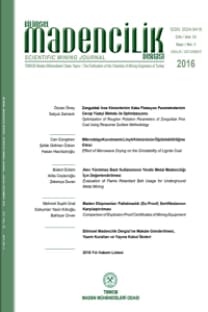Çanakkale - Kayışlar Demir Yatağının Jeofizik (Yerelektrik) Yöntemle Aranması ve Yataklanma Türü
Serpantin kuvars dokunağında karşılaşılan demir oksit magnetittir (Fe 3 04
).
5 ile 10 Ohm-metrelik düşük görünür özdirenciyle magnetit gerek 1 75 ± 25 Ohmmetrelik
serpantin ve gerekse 350-3500 Ohm-metrelik skarndan ayrılabilmektedir.
Yataklaşma biçimi ve varlığını belirlemek üzere doğru akım yerelektrik özdirenç
yöntemi 100 x 210 metrelik dar bir alan içinde 10 metre aralarla 3 doğ
rultu boyunca uygulanmıştır. 25 ve 55 metreler için çıkarılan görünür özdirenç
kaydırma eğrilerinden cevher yerleşiminin, serpantin, dokunak ve skam içi incedirençli
alt sokulumların kenarlarında en çok 5-10 metrelik kalınlıklarda ve 10
ile 50 metre arasında değişen derinliklerde yeraldığı bulunmuştur. Getirici kayaç
350-3500 Ohm-metrelik özdirenç kıyısındaki iletken cevherli kuşaktan kolayca
ayrılmaktadır.
Süreksizler genellikle K50°B uzanımlı olup cevher yerleşiminin 10 ile 40 metre
arası genişliklerde uzanan iletken kuşaklar içinde yataklandığı sanılmaktadır.
Jeofizik yaklaşımla belirlenen yataklaşma biçimi, cevherin minerolojisi ve yeryapısal
özelliklere bakarak oluşumun kontak pnömatolik türeme olduğu yargısına
varılmıştır. Jeofizik belirtilerin cevhere bağlanması sonucu dar alandan beklenen
cevher tutarının 33700 ton olabileceği beklenmektedir.
Exploration of the Canakkale - Kayışlar Iron Deposit By Use of Geophysical (Geoelectrical) Technic
Magnetite (Fe 3 04
) is the iron oxide deposit which has prospected around
quarsite contact with ultrabasic rock. Because of high resistivity contrast it
became possible to discriminate magnetite, with 5-10 Ohm-m apparent resistivity
from the host rock serpantinite with 175 ±2 5 sistivities. Direct current geoelectrical
resistivity method has been applied to determine deposition type and
existance in the prospect area which has dimension of 100 by 210 meters and
along the three profiles with intervals of 10 meters. Resistivity profilings for
25 and 55 meters of expansions reveal that deposition underlies serpantinite
and skarn and also takes place in contact zone. Resistive and thin intrusions are
thougt to be responsible to carry up mineralizations at its flanks with the thickness
of at most 5 to 10 meters and with the depth of 10 to 50 meters. Such
transporters are recognized with higher resistivity ranged between 350-3500 Ohmmeters
and easly identified from the conductive mineral zones which show relatively
low resistivities.
It is assumed that deposition furnished in conductive zones in approximately
N50W direction and with a varying width of 10 to 40 meters. Depositional type
defined by the geophysical approach, minerological properties and characteristic
geology of the invorcnment indicate that mineral occurence in the area is contact
pynomatolytic type. Expected apparent ore reserve, from this limited area, is
approximately 33700 tons which was estimated from the geophysical anomalies
correlated by magnetite exposures on themsclf.
- ISSN: 2564-7024
- Yayın Aralığı: Yılda 4 Sayı
- Yayıncı: TMMOB Maden Mühendisleri Odası
